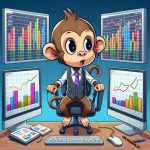
Harnessing the Market Fear and Greed Index: A Contrarian’s Guide to Investing
Oct 25, 2024
Introduction: Navigating the Emotional Tides of the Market
The investing world is often driven by two powerful and opposing forces: fear and greed. These primal emotions can cloud judgment, lead to impulsive decisions, and significantly impact market behaviour. The Stock Market Fear and Greed Index is a fascinating contrarian tool that measures these emotions to gauge market sentiment. In this article, we delve into the depths of this intriguing index, exploring its potential to navigate the treacherous waters of fear and folly in investing.
An old Wall Street adage states that the market is driven solely by fear and greed. While this is an oversimplification, it holds a grain of truth. These emotions can shape investor portfolios, influence the stock market’s stability, and even impact the broader economy. Emotional biases occur when fear or greed cloud judgment, leading to impulsive actions or distorted perceptions of risk and reward.
The Fear and Greed Index assumes that fear drives stock prices down while greed propels them upward. It is calculated using seven key indicators, each measuring a distinct aspect of stock market behaviour. With a score ranging from 0 to 100, the index provides a snapshot of market sentiment, where 0 represents maximum fear and 100 signals rampant greed.
However, the index is more than just an emotional barometer. It alerts investors to their biases and emotional responses, which can influence their decision-making. When used with fundamental analysis and other technical tools, the Fear and Greed Index becomes a valuable compass for navigating volatile markets. As legendary investor Warren Buffett observed, extreme fear and greed will forever colour the investment landscape, driving the highs and lows of market cycles.
To make prudent investment decisions, it is essential to understand the motivations behind emotional investing and to avoid the traps of euphoria and depression. Greed can lead to buying at market tops, while fear can result in selling at the bottom. By recognizing and acknowledging these emotions, investors can master their responses and make more rational choices.
Unraveling the Fear and Greed Index: A Contrarian’s Toolkit
The Fear and Greed Index is a composite of carefully selected indicators, each offering a unique perspective on market sentiment. This index, favoured by contrarian investors, provides a numerical representation of the market’s emotional state, ranging from extreme fear to excessive greed. Let’s explore the three key components that contribute to the insights offered by this index:
Volatility Index (VIX): The Fear Gauge
The VIX, often dubbed the “fear index,” measures market volatility derived from options pricing. When fear and uncertainty surge, the VIX tends to spike, indicating that investors may become more risk-averse. Conversely, a low VIX suggests a stable market environment characterized by relative confidence. During the 2008 financial crisis, the VIX reached unprecedented heights, reflecting the extreme fear and uncertainty that gripped the market.
Put/Call Ratio: A Window into Market Sentiment
This ratio compares the number of put options (bearish bets) to call options (bullish bets). A high put/call ratio indicates heightened fear and a potential market downturn as investors lean towards protective strategies. On the other hand, a low ratio signals optimism and bullish sentiment. For example, during the Dotcom bubble of the late 1990s, the put/call ratio was meagre, reflecting the market’s excessive greed and bullish enthusiasm.
Breadth Indicators: Gauging Market Participation
Breadth indicators provide a panoramic view of market participation by examining the number of advancing versus declining stocks. A wide breadth, with many advancing stocks, signals broad market strength and investor confidence. Conversely, a narrow breadth, where declining stocks dominate, suggests increased caution and potential market weakness. During the market recovery following the 2008 financial crisis, breadth indicators showed a significant increase in advancing stocks, indicating a return of investor confidence and a shift from fear to greed.
Deciphering the Emotional Thermometer of the Market
Like an emotional thermometer, the Fear and Greed Index quantifies investor sentiment on a scale from 0 to 100. Extreme fear (0-20) suggests oversold conditions and potential buying opportunities, while extreme greed (81-100) indicates overbought scenarios and the risk of corrections. This index incorporates indicators like the VIX, which spiked during the 2008 financial crisis, and the Put/Call Ratio, which was notably low during the Dotcom bubble, signalling excessive optimism.
Navigating these emotional tides requires a contrarian mindset, a strategic approach that goes against the grain of popular sentiment. Contrarian investors, like the Medici family, embrace the wisdom of John Templeton’s famous quote, “The time of maximum pessimism is the best time to buy, and the time of maximum optimism is the best time to sell.” They make calculated moves based on critical thinking and discernment, positioning themselves against the tide of mass psychology.
During the 2008 crisis, contrarian investor Howard Marks of Oaktree Capital seized the opportunity to buy undervalued assets amidst the prevailing fear. Conversely, Warren Buffett’s prudence during the Dotcom bubble led him to avoid tech stocks, which paid off when the bubble burst.
William James Sidis, a child prodigy with an estimated IQ of 250-300, reminds us of the importance of intellectual independence. Despite his extraordinary intellect, Sidis faced challenges from societal pressures, underscoring the need for balance in personal and financial endeavours.
The contrarian mindset allows investors to exploit market inefficiencies from irrational fear or exuberance. It focuses on the intrinsic value of investments, echoing Benjamin Graham’s belief that “price is what you pay, but value is what you get.” Armed with insight and resilience, contrarian investors chart a path that diverges from the crowd, setting themselves up for long-term success in the dynamic world of finance.
Recognizing the Limitations of the Fear and Greed Index
While the Fear and Greed Index is a valuable sentiment indicator, it has limitations. It captures the market’s prevailing mood but doesn’t account for all market dynamics. For instance, it may not reflect fundamental factors like a company’s financial health or broader economic trends, which are crucial for comprehensive investment analysis.
The index’s reliance on emotional sentiment also means it cannot predict market trends influenced by economic indicators, industry developments, or global events. Geopolitical events, in particular, can significantly impact markets, extending beyond what sentiment indicators can measure.
Historically, the index has shown its limitations during significant events. For example, during the 2008 financial crisis, while the index indicated extreme fear, it could not predict the duration of the crisis or the subsequent recovery trajectory. Similarly, high levels of greed were reflected during the Dotcom bubble, but the index could not foresee the bubble’s burst or the following market correction.
Investors should, therefore, use the Fear and Greed Index as one tool in their arsenal, combining it with fundamental analysis and other technical indicators to make well-rounded investment decisions.
Mastering the Art of Navigating Fear and Folly: A Fierce Finale
Numbers may guide us, but the unyielding courage of the human mind conquers the chaos. While a compass to sentiment, the Fear and Greed Index is no sovereign over success—it is a servant to those bold enough to wield it with precision and purpose. Markets do not reward the timid nor the reckless but those who dare to walk the razor’s edge between caution and conviction, between the whispers of fear and the roars of greed.
The financial storms of 2008 and the frenzy of the Dotcom bubble were not merely tales of ruin—they were crucibles for the audacious. Those who saw opportunity where others saw despair, who stood vigilant while others revelled in mania, emerged not as victims of sentiment but as masters of it. To navigate such treacherous waters, one must see the tides and understand the currents beneath—a feat achieved not through blind faith in tools but through insight, discipline, and an unrelenting hunger for truth.
Niccolò Machiavelli, the renowned Italian philosopher, once said, “It is not titles that honour men, but men that honour titles.” In the context of investing, it is not the tools we use that define our success but our ability to utilize them and adapt to changing market conditions effectively.
Remember this: the market owes you nothing. It is a battlefield; only those who sharpen their strategies, temper their emotions, and challenge the herd will claim victory. Like the philosopher who taught us that honour lies not in titles but in action, investing triumphs are not born of blind allegiance to tools but of the wisdom to use them as allies in an ever-shifting world.
To master the art of investing is to embrace the paradox of fear and greed. It is to reject the comforting simplicity of absolutes and instead revel in the complexity of nuance. It is to wait when the world rushes and act when the world hesitates. This is not a game for the faint of heart but a pursuit for the daring, the disciplined, and the relentless.
Immersive Insights: Deep-Dive Articles










